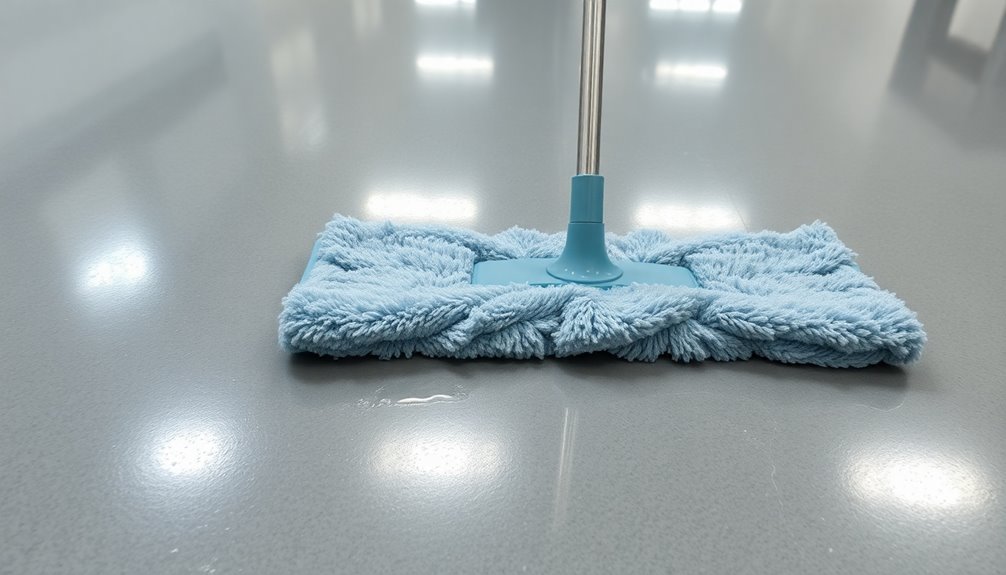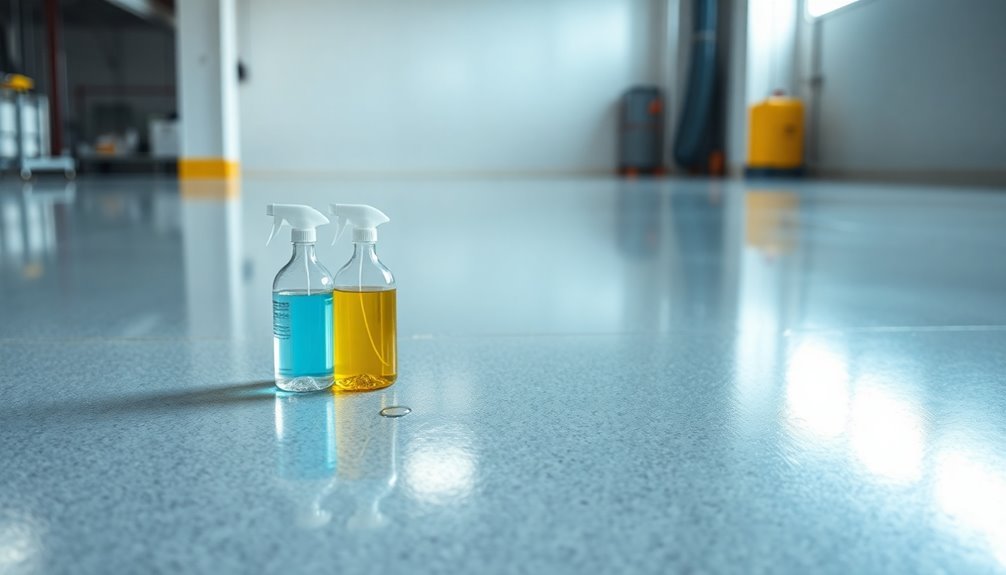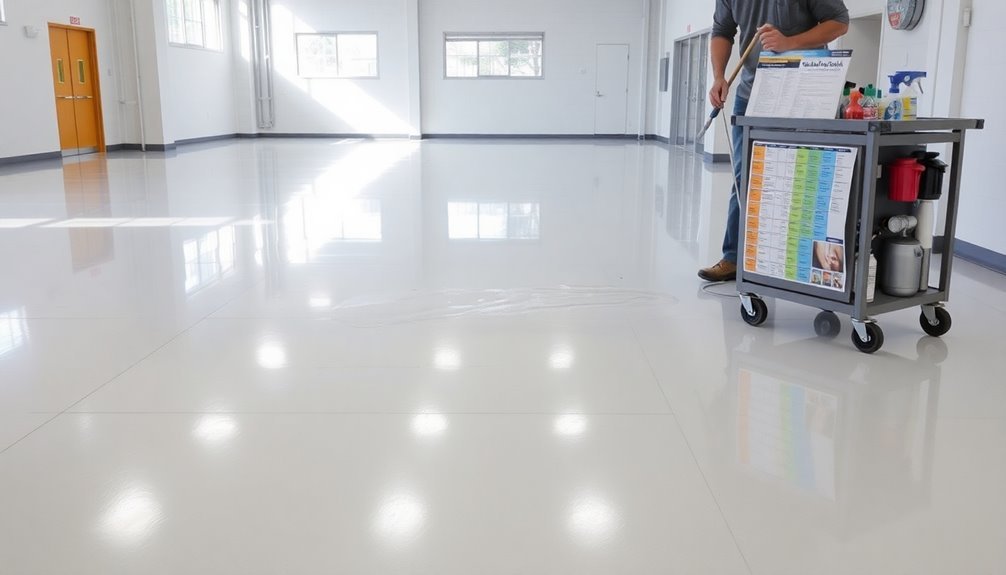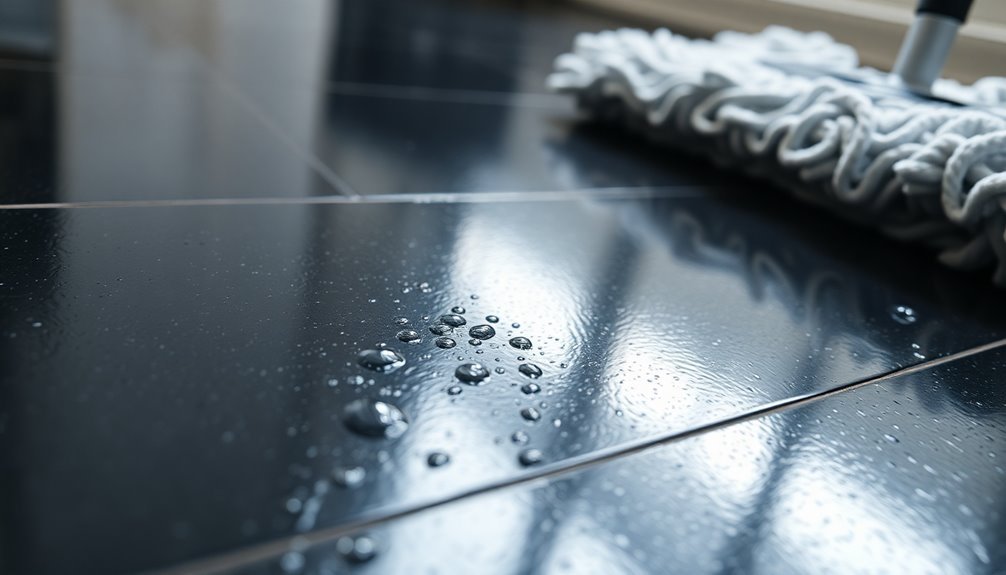To properly maintain dissipative flooring, you'll need to follow five key practices. Start by sweeping daily with ESD-safe tools and specialized cleaning products, avoiding standard household cleaners that leave problematic residue. Make sure you're conducting regular surface resistance testing to verify performance, aiming for readings below 1×10^6 ohms. Keep up with preventive maintenance by reapplying topcoat every 4-6 weeks and scheduling annual deep cleaning. Always match your cleaning chemicals to your specific flooring type, and repair any damage immediately to maintain uniform static protection. These fundamentals will help you develop a more thorough maintenance strategy.
Floor Preparation Best Practices

Getting down to proper floor preparation involves several essential steps that protect your investment and guarantee long-lasting results.
You'll need to start by completely clearing the area of all furniture and thoroughly cleaning the surface to remove dust, dirt, and existing coatings that could interfere with proper adhesion. The proper disposal methods for removed materials help maintain a safe work environment.
Before proceeding, you'll want to conduct a detailed inspection of your subfloor to identify any structural issues, moisture problems, or damage that needs addressing.
If you're working with existing flooring, you must remove it entirely, including any residual adhesive, to provide a clean foundation for your new installation.
Don't skip moisture testing – it's vital for preventing future problems. Use appropriate testing methods to check moisture levels, as excess moisture can lead to adhesive failure and flooring damage.
When you discover issues during inspection, address them immediately by repairing cracks, filling gaps, and applying self-leveling compounds where needed.
For best results, you'll need to sand and smooth the subfloor to create an even surface.
Remember to patch any cracks with suitable filling materials and confirm the entire surface is level before moving forward with your installation.
Daily Cleaning Essential Steps
Once your floor is properly prepared and installed, maintaining its dissipative properties requires a structured daily cleaning routine.
Start by using an ESD-safe dustpan and broom to sweep your floor daily, especially in high-traffic areas. This prevents static buildup and removes dirt that could compromise the floor's dissipative properties. Maintaining humidity levels between 30-70% helps prevent excess static during cleaning operations.
When mopping, you'll need to use specialized ESD-safe cleaning products that match your specific flooring material.
Don't use standard household cleaners, as they can leave residue that interferes with static dissipation. For vinyl floors, use a damp mop and consider burnishing to restore shine. If you have rubber flooring, you can mop with water and use buffing pads for enhanced appearance.
Monitor your floor's performance by taking regular surface resistance readings.
You'll need to reapply a full-strength topcoat every four to six weeks after cleaning to maintain proper dissipative properties.
Inspect your floor daily for cuts, scratches, or peeling, particularly in areas with heavy foot traffic.
When you spot damage, repair it immediately to maintain uniform static dissipation across the entire surface.
Chemical Selection Guidelines

Choosing the right chemicals for your dissipative floor system depends on both the type of flooring material and its intended use.
You'll need to carefully consider your facility's specific requirements and consult chemical resistance charts to make informed decisions about cleaning and maintenance products. Regular testing and inspection of the floors is essential to maintain effectiveness, particularly in busy environments.
When selecting chemicals, you must match them to your flooring type. If you've got an epoxy system, you'll find it offers strong chemical resistance, but you should still verify compatibility with your specific cleaning agents.
For vinyl ester floors, you can typically use a broader range of cleaning chemicals due to their superior chemical protection properties.
Always consider both short-term exposure and continuous contact ratings when selecting cleaning agents. Even if a chemical is rated as compatible, you'll want to factor in temperature conditions and exposure duration, as these can affect your floor's performance.
If you're working with specialized surfaces like Novolac Epoxy, you'll have more flexibility with chemical choices, but don't take this for granted.
Remember that proper chemical selection isn't just about cleaning effectiveness – it's also about maintaining your floor's ESD properties and ensuring compliance with standards like ANSI/ESD S20.20 where applicable.
Surface Testing Requirements
Proper surface testing guarantees your dissipative floor maintains its essential static control properties.
You'll need to conduct at least five tests per continuous floor surface or every 5,000 square feet, following ANSI/ESD S20.20 and ANSI/ESD S7.1 standards. Pay special attention to areas with heavy foot traffic, chemical spills, or visible wear. Your tests should ensure resistance readings are less than 1×10^6 ohms.
You can use a Surface Resistance Test Kit with electrodes or a hand-held surface resistance meter for your measurements. Whichever method you choose, make sure your testing equipment is properly calibrated and both the floor surface and electrodes are clean before testing.
Don't forget to document your findings in an official test report.
You'll want to implement a regular testing schedule that aligns with your maintenance routine. Test after each cleaning session and floor coating application to verify the surface's conductivity.
Remember to sweep daily and perform weekly cleaning to prevent dirt accumulation that could compromise the floor's dissipative properties. You should also reapply a full-strength topcoat every four to six weeks.
This thorough approach guarantees your floor continues to meet required standards while maintaining its static-control effectiveness.
Preventive Maintenance Schedule

To maximize the longevity of your dissipative floor, you'll need to follow a structured maintenance routine that combines daily, weekly, and periodic care.
Start each day by sweeping or vacuuming to remove loose debris, followed by dry mopping to prevent moisture accumulation. Always use fresh, clean equipment to avoid cross-contamination. Don't forget to place entry mats and tack mats at strategic points to minimize contaminants.
Your weekly maintenance should include damp mopping with properly diluted, neutral pH cleaners specifically designed for ESD floors. For high-traffic areas, you'll want to use machine cleaning for better results.
Every 4-6 weeks, reapply a full-strength topcoat to maintain the floor's dissipative properties.
Long-term care requires regular surface resistance testing to monitor performance. You'll need to implement annual stripping and refinishing, though this may be more frequent depending on wear.
When refinishing, apply multiple thin coats, allowing proper drying time between applications. Remember to avoid harsh solvents or cleaners that could damage the floor's electrical properties.
For high-traffic zones, incorporate spray buffing or burnishing according to your manufacturer's recommended schedule.
Frequently Asked Questions
Can Dissipative Flooring Be Installed Over Existing Concrete Floors?
Yes, you can install dissipative flooring over existing concrete floors if they're clean, dry, and properly prepared. You'll need to guarantee there's no excessive moisture and the surface meets specific conditions for compatibility.
How Long Does ESD Flooring Typically Last Before Requiring Complete Replacement?
You'll find ESD flooring lifespan varies by type – vinyl can last 20+ years with proper care, while epoxy typically needs replacement or recoating after 10 years. Regular maintenance greatly extends the floor's functional life.
Does Humidity Affect the Performance of Dissipative Floor Surfaces?
Yes, humidity greatly affects your dissipative floor's performance. You'll notice better conductivity and static dissipation at higher humidity levels (40-60% RH), while dry conditions can reduce your floor's ESD protection capabilities.
What Footwear Is Compatible With Dissipative Flooring in Non-Industrial Settings?
You'll need ESD-compliant footwear like dissipative shoes, heel straps, or toe straps for dissipative flooring. Look for footwear marked as "static dissipative" or "ESD-safe" that's comfortable for office wear.
Can Heavy Equipment Movement Damage the Conductive Properties of Dissipative Floors?
Yes, if you're moving heavy equipment, it can damage your dissipative floor's conductive properties. You'll want to use protective mats and follow designated pathways to prevent cracks and surface damage that compromise conductivity.
In Summary
You'll extend your dissipative floor's lifespan by following these five essential maintenance practices. Remember to properly prepare surfaces, stick to daily cleaning protocols, use only approved chemicals, conduct regular testing, and maintain a consistent preventive care schedule. Don't skip steps or take shortcuts – your floor's static dissipative properties depend on proper care. When in doubt, consult your flooring manufacturer's specific guidelines.





Leave a Reply